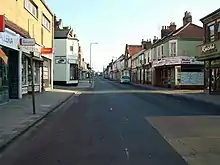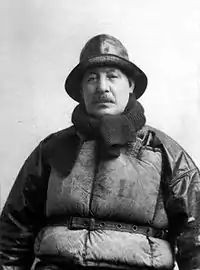Gorleston-on-Sea
Gorleston-on-Sea (/ˈɡɔːlstən/), known colloquially as Gorleston, is a town in Norfolk, England, to the south of Great Yarmouth. Situated at the mouth of the River Yare it was a port town at the time of the Domesday Book. The port then became a centre of fishing for herring along with salt pans used for the production of salt to preserve the fish. In Edwardian times the fishing industry rapidly declined and the town's role changed to that of a seaside resort.
| Gorleston-on-Sea | |
|---|---|
 The Pavilion Theatre | |
 Gorleston-on-Sea Location within Norfolk | |
| Population | 5,548 (2011 Census.Ward)[1] |
| OS grid reference | TG520040 |
| District | |
| Shire county | |
| Region | |
| Country | England |
| Sovereign state | United Kingdom |
| Post town | GREAT YARMOUTH |
| Postcode district | NR31 |
| Dialling code | 01493 |
| Police | Norfolk |
| Fire | Norfolk |
| Ambulance | East of England |
| UK Parliament | |
History

The place-name 'Gorleston' is first attested in the Domesday Book of 1086, where it appears as Gorlestuna. It appears as Gurlestona in the Pipe Rolls of 1130. The first element may be related to the word 'girl', and is probably a personal name. The name could mean "girls' town or settlement", or a variant thereof, similar to Girlington in West Yorkshire.[2]
Historically the town was in the county of Suffolk. In the Middle Ages it had two manors, and a small manor called Bacons. In 1832, it became a part of Great Yarmouth for electoral purposes. Finally in 1835 it merged with the town and became part of Great Yarmouth in the county of Norfolk. Gorleston Barracks were established in 1853.[3] There used to be two railway stations. Both were on the coastal line which joined Great Yarmouth with Lowestoft - Gorleston-on-Sea closed in 1970 whilst its neighbour, Gorleston North closed in 1942.
It is a seaside resort and tourist destination. Its main attraction is its sandy "Edwardian Beach." It has traditional seaside gardens and model boat pond. It also has a theatre opposite the pier called the Pavilion. The main shopping centre is on High Street. It has its own golf club. There is also the hospital and a library. The nearest railway station remaining open is the Great Yarmouth railway station. There is a lighthouse, lifeboat station and coastwatch station on Riverside Road.[4]
St Peter the Apostle Roman Catholic Church, built in 1938–39, was Eric Gill's only complete work of architecture.
In the Great Storm of 1987, Gorleston-on-Sea experienced the highest wind speed recorded in the UK on that day, which was 122 mph (196 km/h).
The town is meticulously described in the novel Gorleston by Henry Sutton (Sceptre, 1995) and in Philip Leslie's novels The History of Us (Legend Press, 2009) and What Remains (December House, 2013). Both Sutton and Leslie employ the actual names of roads and retail outlets in their work.
Gorleston-on-Sea's Pier Hotel and beach feature as a key location in Danny Boyle's 2019 film Yesterday.[5]
East Anglian School for Deaf and Blind Children
The East Anglian School for Deaf and Blind Children (for deaf children and for blind children) was established in Gorleston in 1912 and based there until it closed in 1985.[6] During the Second World War the school was evacuated to Aberpergwm House in Glynneath, Wales.[7] The headmaster's house in Gorleston was severely damaged by bombing in 1941.[8]
Education
There are a number of primary schools in the area serving Gorleston and the wider locality. Secondary schools include Cliff Park Ormiston Academy, Lynn Grove Academy and Ormiston Venture Academy.
East Norfolk Sixth Form College is located in Gorleston. It is a major sixth form provider in Norfolk, attracting students from a wide area.
Notable people

- William Adams (1864–1913) highly decorated lifesaver and swimming instructor[9]
- William Fleming GC (1865–1954) highly decorated lifeboatman[10]
- Rowland Fisher (1885–1969) painter,[11] mainly known for his seascapes
- Maurice Kaufmann (1927–1997) actor[12] on stage, film and TV, married to Honor Blackman 1961-1975
- Peter Simpson (born 1945) former football player,[13] 370 pro appearances for Arsenal F.C.
- Sammy Morgan (born 1946) former pro. footballer,[14] making over 260 appearances
- Henry Edward Sutton (born 1963) Senior Lecturer[15] in Creative Writing at the University of East Anglia and award-winning crime novelist
- Paul Derek Gibbs (born 1972) former professional footballer,[16] approx. 200 pro. appearances.
- Myleene Klass (born 1978) TV presenter,[17] musician and former member of pop group Hear'say
- Hannah Spearritt (born 1981) actress[18] and former member of pop group S Club 7, grew up in Gorleston
- Gregg Lowe (born 1986) actor[19][20]
See also
- Gorleston F.C., a Non-League football club who play at Emerald Park in Gorleston-on-Sea
References
- "Great Yarmouth Ward population 2011". Retrieved 24 August 2015.
- Eilert Ekwall, ' 'The Concise Oxford Dictionary of English Place-names, p.201.
- Historic England. "Southtown Road Workshop Range (1245811)". National Heritage List for England. Retrieved 17 October 2016.
- RNLI history of Great Yarmouth & Gorleston lifeboat station Archived 8 January 2009 at the Wayback Machine.
- "Pier Hotel Gorleston". Retrieved 13 July 2019.
- "East Anglian School for the Deaf and Blind". Norfolk Deaf History. Archived from the original (GIF image) on 19 April 2015. Retrieved 9 April 2015.
- Gosse, Peter. "EAS moved to Wales During the War 1940-1945" (PDF). Norfolk Deaf History. Archived from the original (PDF) on 19 April 2015. Retrieved 9 April 2015.
- Clapham, Lucy (10 December 2012). "Blue plaque marks the spot of important Gorleston landmark". East Anglian Daily Press. Retrieved 15 November 2014.
- Gorleston & Great Yarmouth History website, William Adams retrieved January 2018
- Great Yarmouth Mercury, 14 October, 2017, Blue plaque to honour Gorleston lifeboat coxswain retrieved January 2018
- Hatfield Hines Galleries website, Rowland Fisher, 1885-1969 retrieved January 2018
- IMDb Database retrieved January 2018
- North American Soccer League Players, Peter Simpson retrieved January 2018
- Gorleston F.C website, Previous managers retrieved January 2018
- Henry Sutton, Biography, University of East Anglia retrieved January 2018
- SoccerBase Database retrieved January 2018
- IMDb Database retrieved January 2018
- IMDb Database retrieved January 2018
- Coates, By Liz. "Clinically dead X-Men actor revived at end of marathon". greatyarmouthmercury.co.uk. Retrieved 14 August 2017.
- IMDb Database retrieved January 2018
Sources
- Norfolk Record Office Information Leaflet 33: Great Yarmouth, (Norwich: Norfolk Record Office, 2006)
External links
| Wikimedia Commons has media related to Gorleston-on-Sea. |